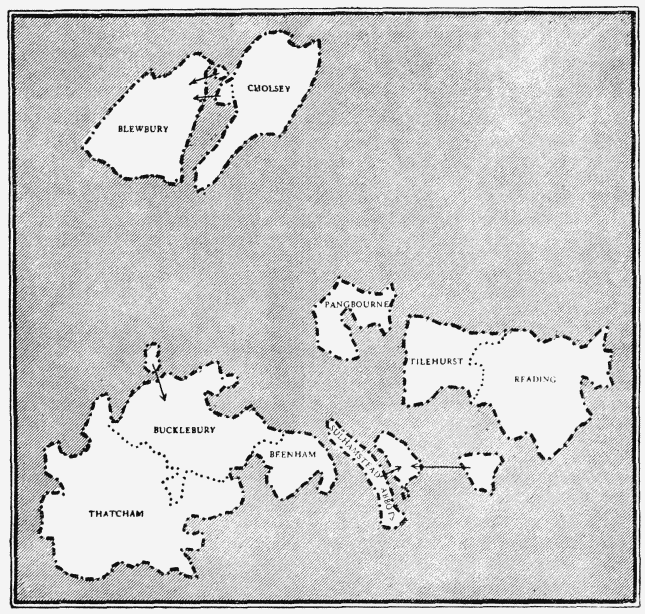Pages 275-276
A History of the County of Berkshire: Volume 3. Originally published by Victoria County History, London, 1923.
This free content was digitised by double rekeying. All rights reserved.
THE HUNDRED OF READING
CONTAINING THE PARISHES OF
| BEENHAM | THATCHAM |
| BLEWBURY with UPTON and ASTON UPTHORPE | TILEHURST (fn. 1) |
| BUCKLEBURY | And the Borough of READING with ST. GILES with WHITLEY and ST. MARY with SOUTHCOT |
| CHOLSEY | |
| PANGBOURNE | |
| SULHAMSTEAD ABBOTS with GRAZELEY (fn. 2) | |
The hundreds of Reading and Theale were both included in Reading Hundred at the time of the Domesday Survey, when the whole was assessed at 111 hides and 2 virgates; in the reign of the Confessor the assessment had been 146 hides. (fn. 3) Neither Sulhamstead Abbots, Beenham nor Tilehurst is mentioned in the Survey. The last two may possibly have been included in Reading Manor. (fn. 4) The tithing of Beech Hill in Stratfield Saye is also absent, while Blewbury, Bucklebury and Thatcham belonged respectively to hundreds bearing their names, (fn. 5) and Cholsey to 'Esliteford.' (fn. 6) The hundred was granted by Henry I to Reading Abbey at its foundation, the men of the adjacent manors being bound to come to the court according to custom. (fn. 7) The grant, however, seems to have led to a reconstruction of the hundred, which was formed of the manors, with their dependent manors, held by the abbey in demesne in Berkshire. The abbot's liberty was divided into the hundred 'intrinsecus' of Reading, the hundred of Theale and the borough of Reading, whilst to Reading, Hundred were transferred the townships of Bucklebury, Cholsey, Windsor Underore, and part of Blewbury, Thatcham and East Hendred, all of which were held by the abbey. The exact date when this division took place is uncertain, but it was certainly before 1241. (fn. 8) The manor of Windsor Underore was included in Reading Hundred in 1327. (fn. 9) Beech Hill, then called Trunkwell, and Southcot belonged to Theale in the reign of Edward I (fn. 10) and continued to be members of that hundred as late as 1549, (fn. 11) when Reading was held by the Duke of Somerset, at which date the only townships represented at the hundred court were Pangbourne, Whitley, Battle, Sivearstrete, Stratfield Mortimer and part of Stratfield Saye, the tithing of Trunkwell (fn. 12) being excepted. In 1666 the hundred was practically the same as in 1831, (fn. 13) and there have been few alterations since that date. Grazeley was formed into a separate parish in 1854 and Beech Hill in 1868, while Cholsey, after being for some time a member of Moreton Hundred, returned to Reading between 1899 and 1911. Upton and Aston Upthorpe, formerly hamlets of Blewbury, but now forming a separate parish, are in Moreton Hundred.

Index Map to the Hundred of Reading


